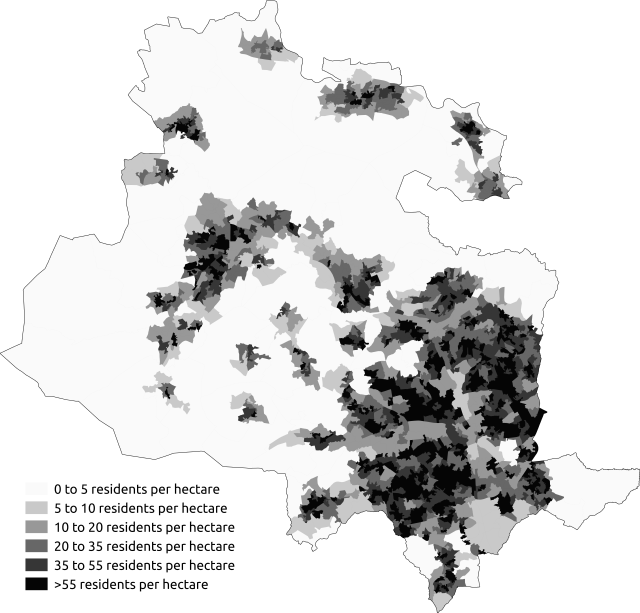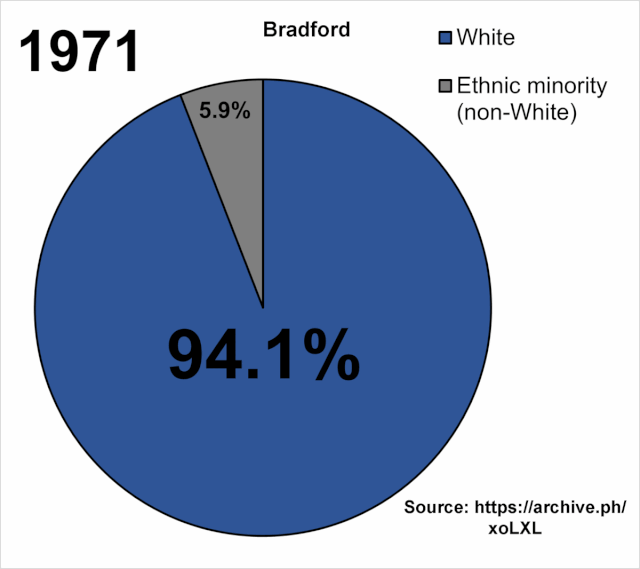Top Qs
Timeline
Chat
Perspective
Demographics of Bradford
From Wikipedia, the free encyclopedia
Remove ads
Bradford, England is an ethnically and culturally diverse city. The City of Bradford metropolitan borough is the sixth most populous local authority district in the United Kingdom, and includes not only Bradford but also the towns and villages of Keighley, Shipley, Bingley, Ilkley, Haworth, Silsden, Queensbury, Thornton and Denholme.

Remove ads
Built-up area
The Office for National Statistics identifies "Bradford Built-up area subdivision", defined by its own algorithm,[1] as an area of 81.74 km2 (31.56 sq mi) with a 2011 population of 349,561 and a density of 4,280 people per square km.[2] It is a subdivision of the West Yorkshire Built-up Area.
Population
The City of Bradford's total population, according to the 2011 UK census, was 522,452. The population density was 1,428 people per square km.
Ethnicity
Summarize
Perspective



The following table shows the ethnic group of respondents in the 1991, 2001 and 2011 censuses in the City of Bradford.
Bradford has had a significant Pakistani population since post war migration began, making up around 25.5% according to the 2021 census. This increase in Pakistanis has generally provided the majority of the growth of the multi-ethnic group of Asian British people within the city. Around 63.9% of the population identify as White British. The black population of Bradford is small, making up just 1.8% of the overall population.
Notes for table above
- New category created for the 2011 census
- In 2001, listed under the 'Chinese or other ethnic group' heading.
- New category created for the 2011 census
Distribution of ethnic groups in the Bradford Metropolitan District Council area according to the 2011 census.
- Population pyramids of ethnicities in Bradford in 2021
- White British
- Asian: Total
- Asian: Pakistani
Ethnicity of school pupils
The ethnicity of school pupils within Bradford has been in flux, with the native White British population declining from a majority of 61.7% in 2004 to a minority of 40.1% of the total school pupil population. This shift has turned Bradford's schools into a majority-minority state, where there are no overall majorities. Asian British school children have risen from 33.1% of the school pupil population to a stagnate 42.7% in 2022, having declined the previous two years from 43.1% in 2020. The largest group within this multi-ethnic amalgamation is British Pakistanis at 36.4% of the total school population. Black British school pupils have risen slightly from 1% to 1.9% with the majority of growth coming from Black Africans. Other groups such as Other ethnicities, Other Whites and Mixed people have also increased as well.
Remove ads
Country of birth

Remove ads
Languages
The most common main languages spoken in the City of Bradford according to the 2011 census are shown below.[19]
Remove ads
Religion

The following table shows the religion of respondents in the 2001, 2011 and 2021 censuses in the City of Bradford.
Remove ads
Industry

Manufacturing in Bradford has collapsed since the middle half of the 20th century.
See also
- Demographics of West Yorkshire
- Demographics of the United Kingdom
- Demographics of England
- Demographics of London
- Demographics of Birmingham
- Demographics of Greater Manchester
- List of English cities by population
- List of English districts by population
- List of English districts and their ethnic composition
- List of English districts by area
- List of English districts by population density
Remove ads
References
Wikiwand - on
Seamless Wikipedia browsing. On steroids.
Remove ads

















